AAEP NEWS 2023
Quick Guide to Managing Foot Abscesses
By Marie Rosenthal, MS
Foot abscesses that continue to drain or recur are a “troublesome thing,” said Craig Lesser, DVM, CF, a podiatry specialist at Rood and Riddle Equine Hospital, in Lexington, Ky.
“The owners get really concerned by this,” he said at a Burst Session presented at the 69th AAEP Annual Convention in San Diego. However, a closer look usually finds a solution to help the lesions resolve.
Often, the reason for the recurrence is because they take the bandage off and turn the horse out in the mud before the foot has a chance to heal. It quickly becomes packed with mud, which traps bacteria and reinfects the foot.
“And then we're back to square 1 again. There's no question in my mind that is the most common reason [an abscess recurs],” he said, so he typically suggests owners consult a farrier after the abscess is opened to get a shoe or treatment pad on the foot to protect it.
If it truly is a recurrent lesion—not a result of turning the horse out too soon—go back, do a thorough examination of the foot, check the drainage and the amount of inflammation, look for other areas of swelling and take some radiographs.
Dr. Lesser tends not to take radiographs the first time he sees the horse for abscesses.
“My rule of thumb is that if you can't resolve an abscess in 3 days, I'll take an X-ray. That first day that I show up, I don't usually find a lot of value in taking an X-ray,” because it is not going to change treatment, and most simple abscesses will heal within a couple of days.
“But by day 3, that's when I'm starting to worry that we might have some bone damage, and I need a little extra help to get this open,” he said. He takes a lateral and solar margin images to look at the entire surface of the coffin bone to see if there are changes that require a different, more aggressive approach.
The traditional way to treat infected coffin bones is to debride and preform regional perfusions with antibiotics, but Dr. Lesser explained, “I don't do those very often anymore.”
Instead, he lets his little helpers do that. He has been using (maggot) larval therapy because “I'm using fewer antibiotics, and they're a lot faster at cleaning up these infections.”
They do a great job at debridement, he admitted. If using larval therapy, it is important to consult a farrier to place a shoe and a treatment plate on the foot to help keep them in place, as well as to keep the foot off the ground.
“The nice part is it [the plate] stops the ground from touching the bottom of the foot so these access pockets don't get crushed over and over and over again. So it continues to drain and it keeps that area protected,” he said.
Owners might be a little squeamish because they have to change the bandages every other day, and the larvae do increase in size as they feed.
“But it's amazing how fast they clean out the infection. I'm using way fewer antibiotics, and everything's nicely debrided after we're done,” Dr. Lesser said.
A New Way to ‘Recycle’ Your Mare
By Paul Basilio
When a mare loses a fetus, it can take months to get her back into cyclicity, thanks to the enduring nature of endometrial cups.
Endometrial cups are crucial, as they produce the hormone equine chorionic gonadotropin (eCG), which sends signals to the ovary to produce secondary corpora lutea (CLs). The CLs produce immense amounts of progesterone, which can sustain the mare’s pregnancy for approximately the first half of gestation.
“Endometrial cups can also be little buggers,” said Carleigh Fedorka, PhD, assistant professor of equine reproductive physiology at Colorado State. “When the mare loses the fetus, those endometrial cups persist for their entire lifespan, regardless of embryo or fetal viability.”
That means if the mare loses the pregnancy on day 35, those secondary CLs are still going to be producing lots of progesterone, which will keep the mare from cycling back. Up to 10% of pregnancies are lost in the first 60 days, so, that’s a lot of waiting around for a lot of mares.
“We’ve tried a lot of things to hasten the degradation of these cups,” Dr. Fedorka said during a Burst session at the 69th AAEP Annual Convention in San Diego. “We’ve tried surgery, ablation and chemical curettage with kerosene with either inconsistent or no success.”
Settle for the Best
The idea of bringing mares back into cyclicity was put on the backburner until Dr. Fedorka’s friend, theriogenologist Maria Schnobrich, VMD, DACT, called her about a mare with retained endometrial cups.
Dr. Schnobrich asked about Settle, a mycobacterium cell wall fraction (MCWF) immunostimulant used to treat equine endometritis caused by Streptococcus zooepidemicus, which is made by NovaVive. Dr. Fedorka initially laughed at the suggestion, but after a little thought it made more sense.
“Endometrial cups are naturally degraded at 150 days by lymphocytes,” she explained. “We know that Settle can increase the production of a lot of cytokines that recruit the lymphocytes and help develop them into the type of lymphocytes that would be useful.”
She told Dr. Schnobrich: “Obviously, we need to study this.’”
They then set out to develop a protocol.
DIY Recycling
First and foremost, a video endoscope is needed to visualize the endometrial cups and inject them individually. Injection needles will be used to penetrate the epithelium of the endometrium and get the treatment into the stroma.
For their protocol, 2 treatments are performed 7 days apart using 4 vials of Settle during each session. Three people are needed for this: 1 person in the mare, 1 person driving the endoscope, and 1 person injecting the treatment solution.
The treatment solution includes 6 mL of Settle combined with 14 mL of lactated Ringer’s solution.
“You have to visualize each endometrial cup, inject 1 mL of solution, and then find the next cup,” Dr. Fedorka explained.
To test the protocol, her team brought in mares that had aborted at about 45 days’ gestation.
“We brought them in for their hysteroscopy, and we injected the individual cups,” she said. “If we had any treatment solution leftover, we injected it circumferentially around the endometrial cup line. Then we waited 7 days and redid the treatment.”
Results showed consistent, reliably reduced eCG concentrations that were negligible by about day 28. In terms of return to cyclicity, 80% of the treated mares cycled back and came into heat about 24 days after treatment onset.
“We reduced the [return to cyclicity] time by 2 to 3 months,” she added. “We were also lucky to have some incredible theriogenologists take this protocol into the field.”
This is a new protocol that is still experimental. It has been performed on 17 mares. Of those 17, they have a history on 12. Nine are pregnant, according to Dr. Fedorka, and should be foaling this upcoming season.
“I hope you don’t have a mare lose her pregnancy, but if you do, please try the protocol and report back. Let us know if you’re successful, because we would love to get more data and hone the protocol,” she said.
4 Steps to Happy Feet
By Paul Basilio
Although it can be overlooked as an examination target, a sizeable portion of equine lameness starts at the foot.
“The foot will tell us a lot of information very quickly, because it is a structure that is easily deformable,” said Craig Lesser, DVM, CF, of Rood & Riddle Equine Hospital in Lexington, KY. “I encourage people to take a second look at the foot during lameness or prepurchase exams to see if an issue is coming about sooner rather than later.”
During a Burst session at the 69th AAEP Annual Convention in San Diego, Dr. Lesser gave a quick rundown of his thorough foot examinations.
Step 1: Look at the horse
“It all starts with just watching the horse stand there,” he said.
Dr. Lesser will take note of whether the horse is doing any unusual weight shifting, holding itself in an altered posture or standing camped under.
“A lot of hindlimb lameness is related to a negative palmar angle,” he explained. “Look at the overall horse, because that’s going to play into what we’re seeing with the foot.”
Pay special note of how the horse moves the foot as well—not only for signs of lameness, but also to see where it lands, whether breaks over or if the stride might be altered. All of these things could help direct treatment.
Step 2: Touch the foot
“When we actually get down and put our hands on the foot, there’s a lot we can see,” Dr. Lesser said. “We’re looking for layers of distortions, and whether they are due to conformation or if we just left a shoe on a foot for longer than we should have.”
Sheared heels, for example, can be a sign of other issues, and they can be difficult to pick up unless you get down there and look for it.
“Additionally, we can pick up on toe cracks earlier on [with a proper exam],” he said. “A lot of our toe cracks are clinical signs of chronic inflammation in the foot, and quarter cracks could mean an imbalance. We’ll also see bruising before we start to see radiographic changes. A lot of the hoof changes we can see early on will help us get ahead of the game.”
One of the most important things to check, according to Dr. Lesser, is the coronary band.
“It’s not something that I was taught to do right away,” he added. “Now it’s one of the most important parts of my exam.”
Running your fingers along the coronary band can reveal any ledges, sensitivity, or swelling. You may also feel scars or cracks that would have gone unnoticed without the palpation.
“In a lot of our laminitis horses, we’ll start to notice a ledge formation [on palpation],” he said. “The horse might have some signs of sinking that you wouldn’t see radiographically at that point.”
Step #3: Search your sole
“The sole tells us so much” Dr. Lesser explained. “We can start by looking at the frog, which expands and contracts like a muscle. If it’s atrophied, it’s not being engaged. That can indicate that we need to change the shoeing strategy.”
The bar is an extension of the wall. If they’re crushing or rolled underneath, that can lead to lameness and abscessation.
“It’s amazing how many things you’re going to see if you take the time to take your wire brush to the foot and just looking at the bottom of it.”
Step #4: Test the hoof
“No matter how many advanced imaging techniques we have, the hoof tester is still my best tool,” he said. “It helps me tell what hurts and what doesn’t hurt, and helps me decide where we’re going to load and what we need to protect.”
Hoof testers can vary significantly from manufacturer to manufacturer, so Dr. Lesser said that it’s important to find one that fits your hands and your examination needs.
“Finally, don’t be afraid to take radiographs,” he said. “A few radiographs can go a long way.”
Not Many Tools in the Box for Infections During Pregnancy
By Marie Rosenthal, MS
When selecting a medication for an infection in a pregnant mare, it is important to remember that you are treating 2 horses, not just 1.
“We need to be thinking about 2 patients when we're only medicating 1, because anything that we give to the mare has the potential to affect the fetus. And so we need to make sure that it is safe and effective for both of these patients,” said Karen Von Dollen, DVM, MS, DACT, of Hagyard Equine Medical institute in Lexington, KY, at the 69th Annual Convention of the AAEP in San Diego.
Another consideration is the placenta, which is a 6-layer structure that forms a good barrier to many medications. “When we're selecting medication, we need to make sure that it's able to penetrate through all of those 6 layers if that's where we want it to go,” she said.
Unfortunately, there is “a relatively limited medication toolbox that we can reach for,” she explained, particularly for suspected bacterial infections of the pregnant mare—such as nocardioform placentitis—a focal mucoid placental inflammation usually caused by Amycolatopsis spp., and/or Crossiella equi.
Recent studies have looked at penicillin G, gentamicin, trimethoprim-sulfamethoxazole (TMP-sulfa), doxycycline, enrofloxacin and ceftiofur during pregnancy. Pen G and gentamicin cross the placenta and reach the necessary minimum inhibitory concentrations (MICs) to reach therapeutic concentrations, so they are good choices. TMP-sulfa also looks like a good choice, and has the advantage of oral dosing, but it has been tested in experimentally induced ascending placentitis—not in pregnant mares.
However, it does appear to cross the placenta and reach sufficient concentrations needed against the organisms.
There is concern that doxycycline, another choice, might not attain the MICs needed to reach therapeutic concentrations after crossing the placenta. More work is needed in this area, Dr. Von Dollen said.
Enrofloxacin also has potential, but there are questions about the effect of the medication on the foal’s joint development, which makes many veterinarians wary of using this antibiotic during pregnancy. However, a short course of oral treatment (2 weeks) starting late in gestation (around 280 days) did not appear to produce joint toxicities. But again, more data are needed before many veterinarians would be comfortable routinely using this drug, she said.
Ceftiofur, which is available as a crystalline-free acid or as a sodium formulation, would not be a good choice because it does not cross the placenta and cannot reach therapeutic concentrations, she said.
So where does this leave us with antibiotics?
“I give penicillin G, gentamicin and trimethoprim-sulfas a green light for using in pregnant mares,” Dr. Von Dollen said. “When you have suspected bacterial infections, I give a yellow light to doxycycline and enrofloxacin, but you should use those with the knowledge that with doxycycline we're not reaching really high concentrations in fetal fluids. And enrofloxacin would be most appropriate for mares where you're not trying to treat the pregnancy, but perhaps a mare with a bacterial infection somewhere else in her body that you're trying to manage. I give ceftiofur a red light because it is not effective for use in treating issues of pregnancy.”
Supporting Equine Veterinarians’
Well-Being
By Paul Basilio
Equine medicine requires many commitments. A commitment to providing the best care possible, a commitment to staying clinically sharp, and a commitment to those who trust you with their animals’ lives.
What is often overlooked, however, is the commitment to setting professional boundaries and the commitment to your own mental, physical, and emotional well-being.
“It’s why we do it, right?” said Andi Davison, LVT, CAPP, APPC, of Flourish Veterinary Consulting, in an interview with Modern Equine Vet at the 69th AAEP Conference in San Diego. “We got into veterinary medicine to speak for those who couldn’t speak for themselves. We want to provide care, we want to be there for our owners when there is an emergency, and we want to do what we can to help. But we don’t want to do it 24/7, and we don’t want to do it when we’re broken.”
To that end, the Stable Life initiative—launched by Boehringer Ingelheim in 2021—aims to support sustainable well-being among equine veterinarians and their staff. Speakers such as Davison bring targeted information directly to veterinarians via webinars and in-person meetings.
“We deliver evidence-based consulting and coaching services around the idea of culture, leadership, and well-being in the veterinary field,” explained Josh Vaisman, MAPPCP, CCFP, co-founder and owner of Flourish Veterinary Consulting.
At one presentation at the conference, Mr. Vaisman discussed ways to create an environment that allows people to perform at their best and get the most joy from their work—the idea of psychological safety and strong, open collaboration among teams.
“Equine medicine has always had this idea of ‘put your head down and keep working,’” said Jamie Pribyl, DVM, a professional services veterinarian at Boehringer Ingelheim. “There’s always been a pervasive attitude that if you don’t want to suck it up, then this isn’t the career for you. It’s just what you signed up for.”
She added: “There are things about equine medicine that we can’t change. We will always have emergencies, for example. But we don’t have to run at [full speed] all the time. It doesn’t need to be like that, and we can change it.”
At a time when there is a noticeable shortage of equine veterinarians, the effects of burnout and a lack of personal wellness are laid bare.
“We have a small number of graduates who enter equine practice to begin with,” Dr. Pribyl said. “Within 5 years, 50% or more of those that enter equine practice will leave. It’s a small number to start with, and we lose more as we go along.”
It is not a sustainable equation.
“As an industry, I think we’ve started to reach a precipice where the pain of the status quo is being outweighed by the pain of change,” said Mr. Vaisman, who is also author of Lead to Thrive: The Science of Crafting a Positive Veterinary Culture. “Passion gets people into equine medicine, but the rigors of making a career out of it can allow that passion to wane over time. We can, however, create a space where the passion never wanes.”
NEWS
An international research team identified a critical set of 7 genes linked to successful racehorses.
An international research team identified a critical set of 7 genes linked to successful racehorses.
To Prevent the Next Pandemic, Restore Wildlife Habitats
By Krishna Ramanujan, Cornell Chronicle
Preserving and restoring natural habitats could prevent pathogen spillover from wildlife into domesticated animals and humans, according to 2 companion studies. When bats experience loss of winter habitat and food shortages in their natural settings, their populations splinter, and they excrete more virus. When populations break up, bats move closer to people.
Cowtribe First Investment of BI Social Engagments
Cowtribe is the first recipient of investment and non-financial support from the Boehringer Ingelheim Social Engagement (BI SE) initiative, a program which aims to close a critical financing gap for businesses in vulnerable communities. Cowtribe, a last-mile veterinary delivery company from Ghana, leverages technology to help coordinate deliveries of veterinary vaccines and other animal health products to rural and underserved communities, where many farmers depend on just a few animals.
Genome Testing Could Aid Lyme Diagnosis in Equids
By Adam Marcus
A modified genomic test could help equine veterinarians more rapidly and accurately diagnose certain tick-borne infections, new research suggests.

AVMA, USDA Offer Assistance to Hurricane Victims
Funds from the American Veterinary Medical Foundation supported the work of the Florida Veterinary Medical Association, the University of Florida Veterinary Emergency Treatment Service, Greater Good Charities and the Texas A&M Veterinary Emergency Team.
Merck Opens Animal Health Intelligence Manufacturing Facility in Baton Rouge
Merck Animal Health announced the opening of a manufacturing facility for its animal intelligence products in Baton Rouge, La. The facility will broaden the company’s manufacturing capacity and capabilities by establishing a printing, production and distribution facility of Allflex Livestock Intelligence identification ear tags.
Elanco and IDEXX Making Progress on Social Initiatives
Elanco Animal Health and IDEXX recently released reports about their goals to improve the health of animals and people, and work for social equity. “We believe our work to make life better for animals has the potential to make a lasting positive impact on society and the world,” said Jeff Simmons, president and CEO at Elanco. “We are working hard around the globe to increase representation of diverse talent and reduce our own environmental footprint while supporting our customers, advancing their sustainability efforts through environmentally beneficial products, animal welfare consultation and our antimicrobial stewardship guidance.”
Arm Breeders With Knowledge to Control Genetic Conditions
By Marie Rosenthal, MS
Two novel, and relatively rare genetic diseases—equine familial isolated hypoparathyroidism (EFIH) and equine juvenile degenerative axonopathy (EJDA)—are devastating for affected foals, requiring euthanasia because there is no treatment for either one.
Zoetis Foundation and the AVMF Offer New Scholarships for Vet Tech Students
A new scholarship program to support students in veterinary technician programs was announced today by the Zoetis Foundation and the American Veterinary Medical Foundation (AVMF). The Zoetis Foundation Veterinary Technician Scholarship program will provide $1,000 scholarships to up to 270 students. This program is funded by a grant from the Zoetis Foundation and will be managed by the AVMF.
DNA Test Identifies Equine Lyme Disease
By Kitta MacPherson
When the team at Cornell University School of Veterinary Medicine could not detect Borrelia burgdorferi in a horse with neurologic illness, a Rutgers scientist created an ultra-sensitive DNA, test that could have applications for difficult-to-detect illnesses in humans such as Lyme disease.
"Long-Term Relationships Good for Horses, Too
Horses may be more reluctant in new situations if they have a shorter relationship with their owners, multiple handlers or numerous owner-changes. These factors could negatively affect the horse-human interactions in new situations.
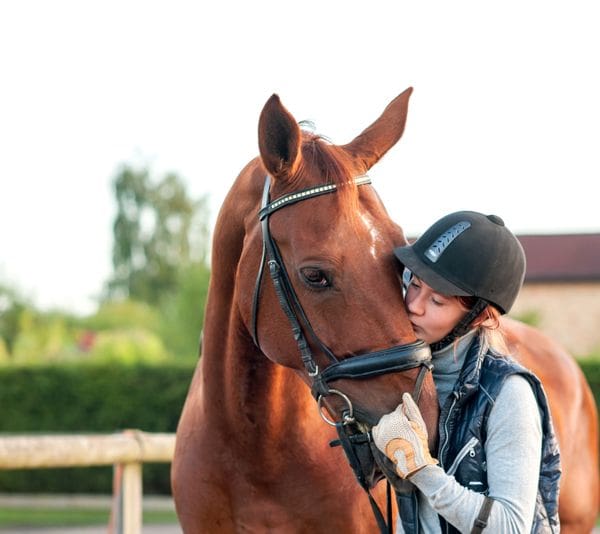
16th Century Horse Specimen Identified From the Americas
A newly identified 16th century horse specimen is among the oldest domestic horses from the Americas known to date, and its DNA helps clarify the history of horses in the Western Hemisphere, according to Nicolas Delsol of the University of Florida, and colleagues.
Call of the Wild” Not Better for Horses
The danger of predators, the search for food and water, and social dynamics—these could be the elements at the basis of a greater level of stress in free-ranging horses, compared with the ones stabled and under human management, according to study done by Italian researchers.
A Horse of a Different Color: Novel Mutation Found in Standardbred Horse
By Lizy Gershony
The field of genetics has enabled people to predict susceptibility to heritable diseases and map the genome of many species. Now, modern genetics and the birth of a unique foal in New Zealand has provided a successful example of tracking a mutation at its origin.
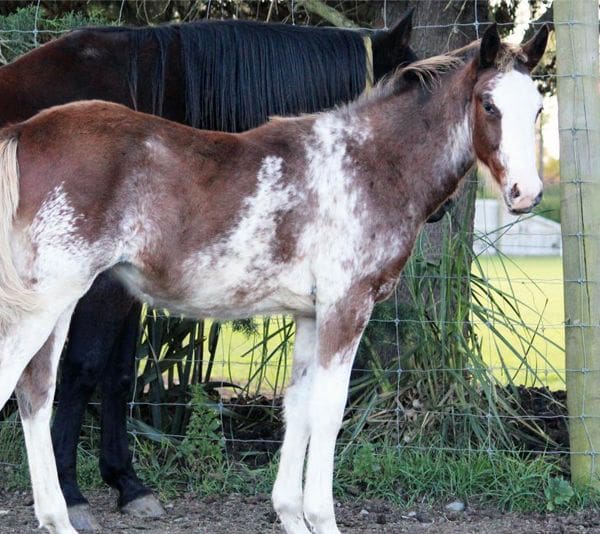
Some Sight for Sore Eyes
By Melanie Greaver Cordova
Jacqueline Rapp, VMD, PhD, of Susquehanna Valley Veterinary in New York was called to check out 3-year-old Quarter horse, Willy. His owners reported that his eye would cloud over one day and be clear the next. He was bumping into things, often cutting his face, and he was also easily spooked.
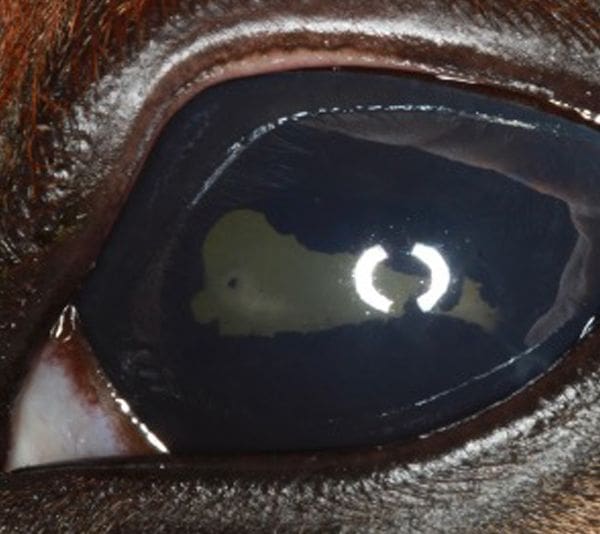
Are You a Horse Whisperer?
How we speak matters to animals. Horses and pigs, both domestic and wild, can distinguish between negative and positive sounds from their fellow species and near relatives, as well as from human speech, according to new research in behavioral biology. And just like people, they tend to react to positivity more than negativity.
Evaluating the Overweight or Obese Horse
By Marie Rosenthal, MS
Every veterinarian has cared for a horse that is at risk for laminitis, insulin dysregulation, heat intolerance, cardiovascular disease and reproductive inefficiency, etc., because it was overweight or obese.
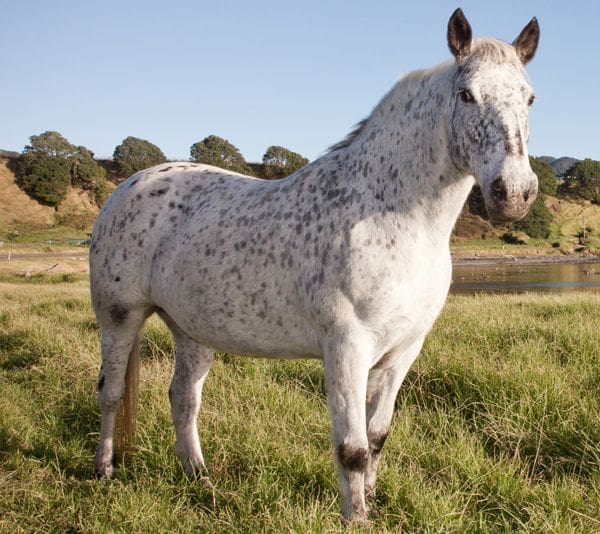
CBD Appears Safe
By Adam Marcus
Supplements containing 150 mg of cannabidiol (CBD) do not appear to cause ataxia or sedation in horses, a new study found. Whether they do anything beneficial is another question, however.
Survey: More Species Threatened Than Thought
An estimated 30% of species have been threatened or driven extinct since 1500 AD, according to a new survey.“Experts also acknowledged substantial uncertainty around their estimates, with perhaps as few as 16% or as many as 50% of species threatened or driven extinct over this time.” said Forest Isbell, PhD, an associate professor in the College of Biological Sciences at the University of Minnesota, who reviewed 3,331 responses from scientists studying biodiversity in 187 countries.
Faults in Show Jumpers Might be Predictable
Faults during show jumping events are driven by several different factors, including course length, arena surface, whether it is held indoors or outdoors, as well as, the experience and skill of the riders. A rivalry between riders also seems to drive faults, according to a recent study from the Czech Republic.

Horses Also Suffering in Ukraine
Horses remain under serious threat within occupied areas of the Ukraine, with horrendous accounts of animal cruelty, while grooms and carers risk their own lives by refusing to abandon them, according to David Rendle, BVSc, MVM, CertEM(IntMed), DipECEIM, MRCVS, the president elect of the British Equine Veterinary Association (BEVA).
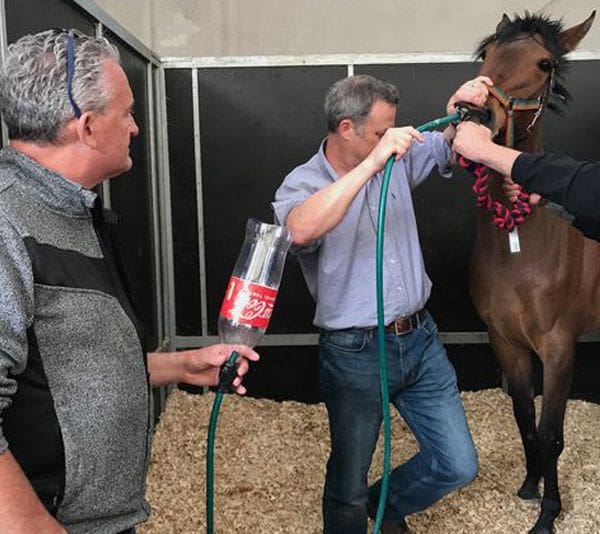
About 27% of Owners Buy Painkillers Without Consulting Veterinarians
Many horse owners purchase painkilling and potentially dangerous drugs without having a veterinarian examine their horse first, a recent survey has found.

What Do You Call the Person Who Assists You?
Only 10 states have a clear definition for the title “veterinary technician” and restrict its use to people with formal credentials in that state, according to a new report by the National Association of Veterinary Technicians in America (NAVTA).
AAEP Issues Equine Piroplasmosis Guidelines
Comprehensive guidelines to assist veterinarians with identification, control and prevention of equine piroplasmosis (EP), a bloodborne protozoal infection of equids with a mortality rate for infected horses of up to 50%, are now available on the AAEP’s website.
USTA Microchips More Than 40,000 Standardbreds
The United States Trotting Association (USTA) has microchipped more than 40,000 Standardbred racehorses in the U.S. using Merck Animal Health Bio-Thermo microchips. USTA partnered with Merck in 2018 to become the first horse registry to formally incorporate temperature scanning into its microchip identification program. USTA is one of the largest users of Merck Animal Health’s Bio-Thermo microchips.
Variation Seen Among People Assessing Equine Pain
Owners and veterinarians do not always agree about the degree of pain a horse might be in, according to a new study. Researchers conducted a cross-sectional study to compare the estimates of pain experienced by horses by veterinarians and horse owners to determine what factors were associated with their perceptions of equine pain.

